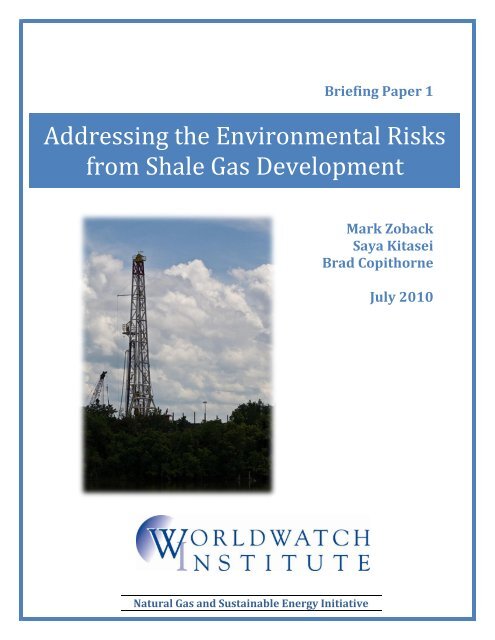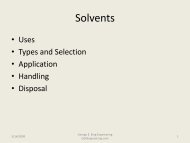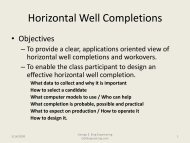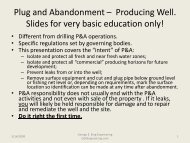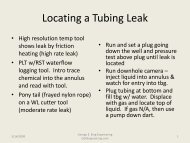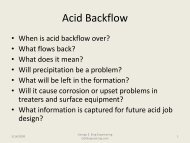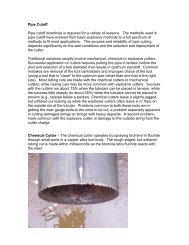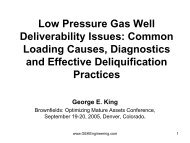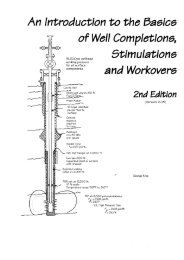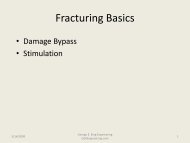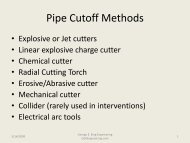Addressing the Environmental Risks from Shale Gas Development
Addressing the Environmental Risks from Shale Gas Development
Addressing the Environmental Risks from Shale Gas Development
Create successful ePaper yourself
Turn your PDF publications into a flip-book with our unique Google optimized e-Paper software.
Briefing Paper 1<strong>Addressing</strong> <strong>the</strong> <strong>Environmental</strong> <strong>Risks</strong><strong>from</strong> <strong>Shale</strong> <strong>Gas</strong> <strong>Development</strong>Mark ZobackSaya KitaseiBrad CopithorneJuly 2010Natural <strong>Gas</strong> and Sustainable Energy Initiative
<strong>Addressing</strong> <strong>the</strong> <strong>Environmental</strong> <strong>Risks</strong> <strong>from</strong><strong>Shale</strong> <strong>Gas</strong> <strong>Development</strong>Mark Zoback a , Saya Kitasei b , Bradford Copithorne cI. Executive SummaryThe rapid development of shale gas resources in <strong>the</strong> past few years has already dramaticallyaffected U.S. energy markets—lowering energy prices and carbon dioxide emissions—and couldoffer an affordable source of low-carbon energy to reduce dependence on coal and oil. 1 However,<strong>the</strong> development of shale gas has been linked to a range of local environmental problems,generating a public backlash that threatens to bring production to a halt in some regions. Whilehydraulic fracturing in particular has been <strong>the</strong> focus of much controversy, our analysis indicatesthat <strong>the</strong> most significant environmental risks associated with <strong>the</strong> development of shale gas aresimilar to those associated with conventional onshore gas, including gas migration andgroundwater contamination due to faulty well construction, blowouts, and above-ground leaksand spill of waste water and chemicals used during drilling and hydraulic fracturing.Many technologies and best practices that can minimize <strong>the</strong> risks associated with shale gasdevelopment are already being used by some companies, and more are being developed. Thenatural gas industry should work with government agencies, environmental organizations, andlocal communities to develop innovative technologies and practices that can reduce <strong>the</strong>environmental risks and impacts associated with shale gas development.Stronger, fully-enforced government regulations are needed in many states to provide sufficientprotection to <strong>the</strong> environment as shale gas development increases. In addition, continued studyand improved communication of <strong>the</strong> environmental risks associated with both individual wellsand large scale shale gas development are essential for society to make well-informed decisionsabout its energy future.This briefing paper, part of an on-going series on <strong>the</strong> role of natural gas in <strong>the</strong> future energyeconomy, provides an overview of how horizontal drilling and hydraulic fracturing are used toextract shale gas, examines <strong>the</strong> environmental risks, associated with shale gas development, andCover photo: A drilling rig near Shreveport, Louisiana, by danielfoster437.a Benjamin M. Page Professor of Geophysics, Stanford Universityb MAP Sustainable Energy Fellow, Worldwatch Institutec Finance Specialist, <strong>Environmental</strong> Defense Fund1
provides an overview of <strong>the</strong> industry best practices and government regulations that are needed ifshale gas is to contribute its full potential to help build a low-carbon economy in <strong>the</strong> years ahead.II.Extracting Natural <strong>Gas</strong> <strong>from</strong> <strong>Shale</strong>Geologists have long been aware that large amounts of natural gas lie trapped in someformations of shale, a sedimentary rock formed <strong>from</strong> deposits of mud, silt, clay, and organicmatter. Over time, that organic matter breaks down, creating molecules of methane, also knownas natural gas. While some of this natural gas migrates into o<strong>the</strong>r formations over millions ofyears, much of it remains trapped in its shale source rock.Although <strong>the</strong> first producing U.S. natural gas well was drilled into a shale formation in NewYork (in 1821), most commercial drilling during <strong>the</strong> 19th and 20th centuries targeted gas that hasmigrated out of its source rock and accumulated in permeable reservoirs such as sandstoneformations. 2 Unlike <strong>the</strong>se ―conventional‖ reservoirs, whose relatively high permeability enablesproducers to extract gas using vertical wells, shale is a much ―tighter,‖ less permeable rock. As aresult, methane molecules cannot flow easily through shale and a vertical well is only able todrain gas only <strong>from</strong> a very small volume of <strong>the</strong> rock surrounding it, which generally preventsvertical wells <strong>from</strong> producing sufficient gas to be economical.Over <strong>the</strong> past decade, however, <strong>the</strong> application of two techniques, horizontal drilling andhydraulic fracturing, has enabled operators to extract gas economically <strong>from</strong> shale formationsthousands of feet deep. Although both technologies originally were developed to increaseproduction <strong>from</strong> conventional wells, <strong>the</strong>ir use in <strong>the</strong> Barnett <strong>Shale</strong>, near Fort Worth, Texas,revealed that <strong>the</strong>y could be <strong>the</strong> key to unlocking <strong>the</strong> trillions of cubic feet of natural gasestimated to exist in shale gas plays throughout <strong>the</strong> United States. 3 (See Figure 1.) At year-end2009, <strong>the</strong> five most productive U.S. shale gas fields – <strong>the</strong> Barnett, Haynesville, Fayetteville,Woodford, and Marcellus shales – were producing some 8.3 billion cubic feet a day, <strong>the</strong>equivalent of nearly 1.6 million barrels of oil a day, or 30 percent of total U.S. crude oilproduction during 2009. 4Figure 1. Map of <strong>Shale</strong> <strong>Gas</strong> Plays, Lower 48 StatesSource: EIA2
Oil and gas drilling generally begins in <strong>the</strong> same way in both vertical and horizontal wells.Operators insert an initial length of steel pipe, called ―conductor casing,‖ into a vertical wellboresoon after drilling begins in order to stabilize <strong>the</strong> well as it passes through <strong>the</strong> shallow, oftenunconsolidated sediments and soils near <strong>the</strong> Earth‘s surface. 5 (See Figure 2.) Then, operatorscontinue drilling vertically and insert surface casing, which most states require to extend <strong>from</strong><strong>the</strong> ground‘s surface past <strong>the</strong> depth of all underground sources of drinking water (USDW‘s). 6Operators <strong>the</strong>n pump cement into <strong>the</strong> casing, followed by water, to push <strong>the</strong> cement out through<strong>the</strong> bottom of <strong>the</strong> casing and back up into <strong>the</strong> space between <strong>the</strong> surface casing and <strong>the</strong> wellbore(called <strong>the</strong> ―annulus‖) until it is entirely filled. Almost all states require <strong>the</strong> surface casing to befully-cemented before drilling is allowed to continue. 7 After <strong>the</strong> surface casing has beencemented into place, regulators may require operators to install blowout prevention equipment(BOPE) at <strong>the</strong> surface to prevent any pressurized fluids encountered during drilling <strong>from</strong> movingup <strong>the</strong> well through <strong>the</strong> space between <strong>the</strong> drill pipe and <strong>the</strong> surface casing. 8Figure 2. Casing and Cementing of a Horizontal Well After allowing <strong>the</strong> cement behind<strong>the</strong> casing to set, operators continuedrilling for a short distance,typically 10 to 20 feet, and test <strong>the</strong>integrity of <strong>the</strong> cement bypressurizing <strong>the</strong> well. They <strong>the</strong>ncontinue drilling vertically untilstate regulations may require <strong>the</strong>insertion of intermediate casing,which can be used to help stabilizedeep wells. In addition, between <strong>the</strong>base of <strong>the</strong> surface casing and <strong>the</strong>target gas-bearing shale formations,wellbores pass through thousands offeet of rock formations. Theseformations may containhydrocarbons, including naturalgas, or briny water containinghighly concentrated salts and o<strong>the</strong>rcontaminants. Intermediate casingis designed to isolate suchSource: GWPC. Not to scale.formations <strong>from</strong> each o<strong>the</strong>r and <strong>the</strong>wellbore, preventing contaminationof <strong>the</strong> gas that will be produced and of freshwater aquifers near <strong>the</strong> Earth‘s surface.When drilling a horizontal well, operators begin turning or ―kicking off‖ <strong>the</strong> drill when <strong>the</strong>y near<strong>the</strong> top of <strong>the</strong> target formation or ―production zone,‖ until <strong>the</strong> wellbore runs through <strong>the</strong>formation horizontally. Horizontal drilling, which can extend up to 10,000 feet, vastly increases<strong>the</strong> wellbore‘s contact with <strong>the</strong> gas-bearing formation relative to vertical drilling, which wouldbe limited to <strong>the</strong> thickness of <strong>the</strong> formation—less than 300 feet in most major U.S. shale plays. 93
After drilling <strong>the</strong> horizontal section of <strong>the</strong> well, operators run a string of ―production casing‖ into<strong>the</strong> well and cement it in place. They <strong>the</strong>n ―perforate‖ <strong>the</strong> production casing using smallexplosive charges at intervals along <strong>the</strong> horizontal wellbore where <strong>the</strong>y intend to hydraulicallyfracture <strong>the</strong> shale.Hydraulic fracturing was first used in <strong>the</strong> late 1940s, and has since become a common techniqueto enhance <strong>the</strong> production of low permeability formations, especially unconventional reservoirssuch as tight sands, coal beds, and deep shales. 10 Hydraulic fracturing is a technically complexprocess. Because most horizontal wells are quite long, operators conduct fracturing in stages,starting at <strong>the</strong> tip or ―toe‖ and proceeding toward <strong>the</strong> end closest to <strong>the</strong> vertical portion or ―heel‖of <strong>the</strong> foot-shaped wellbore. A wellbore that extends 5,000 feet horizontally within a shale layer,for example, might be hydraulically fractured 10 to 15 times at intervals several hundred feetapart. Each perforation interval is isolated in sequence so that only a single section of <strong>the</strong> well ishydraulically fractured at a given time.During a hydraulic fracturing operation, operators pump fracturing fluid at high pressure through<strong>the</strong> perforations in a section of <strong>the</strong> casing. The chemical composition of <strong>the</strong> fracturing fluid, aswell as <strong>the</strong> rate and pressure at which it is pumped into <strong>the</strong> shale, are tailored to <strong>the</strong> specificproperties of each shale formation and, to some extent, each well. When <strong>the</strong> pressure increases toa sufficient level, it causes a hydraulic fracture or ―hydrofracture‖ to open in <strong>the</strong> rock,propagating along a plane more or less perpendicular to <strong>the</strong> path of <strong>the</strong> wellbore. 11 (See Figure3.) A typical hydrofracture isFigure 3. Schematic of Multi-stage Hydraulic Fracturing designed to propagatehorizontally about 500 to 800feet away <strong>from</strong> <strong>the</strong> well in eachdirection and vertically for <strong>the</strong>thickness of <strong>the</strong> shale.Operators monitor and control<strong>the</strong> fracture pressure to preventvertical propagation beyond <strong>the</strong>thickness of <strong>the</strong> gas-producingshale layer. 12One of <strong>the</strong> most noveldiscoveries in <strong>the</strong> Barnett <strong>Shale</strong>was <strong>the</strong> possibility of using―slickwater‖ as a fracturingfluid in deep shale formations.Unlike <strong>the</strong> highly viscous gelsWhen multi-stage hydraulic fracturing is performed, <strong>the</strong> induced used previously to fracturemicroearthquakes generated during each stage are so small <strong>the</strong>y can be conventional formations,detected only using highly sensitive seismometers placed in nearbyslickwater is a more dilute,monitoring wells. The microseismic events occur in <strong>the</strong> rock distributedaround each of <strong>the</strong> hydraulic fracture planes. The hydraulic fracturing is low-viscosity water-based fluiddone sequentially in 10 to 20 stages. Only four stages are shown here designed to carry a smallfor simplicity. The figure is not to scale.amount of sand into fractures toprop <strong>the</strong>m open after <strong>the</strong> pumping stops, allowing gas to escape. Chemical additives are designed4
to inhibit scale and bacterial growth in <strong>the</strong> wellbore, reduce friction, and generally improve <strong>the</strong>effectiveness of <strong>the</strong> fracture job. Slickwater works well in shale gas reservoirs because its lowviscosity allows <strong>the</strong> fracturing fluid to leak out of hydraulic fractures into many small, naturallyoccurring fractures in <strong>the</strong> shale.Slickwater increases water pressure in <strong>the</strong>se microfractures, inducing shear-slip, or microseismicevents that generally have magnitudes of less than -1.5 on <strong>the</strong> Richter scale―about asmuch energy as is released by a gallon of milk dropped <strong>from</strong> chest height to <strong>the</strong> floor. Because of<strong>the</strong> small magnitudes of <strong>the</strong>se events, which represent micro-earthquakes about one-millionth <strong>the</strong>size of tremors that might be detected by inhabitants of a populated area, operators must deployultrasensitive seismometers in nearby monitoring wells in order to detect <strong>the</strong>m. 13 (See Figure 4.)Figure 4 shows microseismic data <strong>from</strong> a well drilled in <strong>the</strong> Barnett <strong>Shale</strong> and hydraulicallyfractured with slickwater in 11 stages. The locations of <strong>the</strong> microseismic events generated duringslickwater hydraulic fracturing provides a picture of where <strong>the</strong> hydrofractures propagated. Thisinformation is important to operators because <strong>the</strong> microseismic events define <strong>the</strong> portion of <strong>the</strong>reservoir stimulated during hydraulic fracturing, increasing <strong>the</strong> shale‘s permeability and allowinggas molecules to flow more easily into <strong>the</strong> production casing.The above-mentioned well targeted a portion of <strong>the</strong> Barnett <strong>Shale</strong> about 330 feet thick and atdepths between about 5,600 and 5,930 feet below <strong>the</strong> surface. The horizontal wellbore is roughly3,800 feet long. Monitoring detected microseismic activity over <strong>the</strong> entire thickness of <strong>the</strong> shale,about 150 feet above and 200 feet below <strong>the</strong> wellbore (Figure 4A), and about 500 to 700 feet toits sides (Figure 4B). Monitoring did not detect microseismic activity any significant distancesabove or below <strong>the</strong> shale formation, suggesting that <strong>the</strong> design of this fracture job successfullyconfined stimulation to <strong>the</strong> target formation. In this case, <strong>the</strong> propagation of fractures into <strong>the</strong>underlying Ellenberger Limestone, which contains highly saline brine, would have allowed brineto contaminate <strong>the</strong> gas in <strong>the</strong> Barnett <strong>Shale</strong>, decreasing <strong>the</strong> efficiency and increasing <strong>the</strong> cost ofits extraction. No microseismic events with magnitudes greater than -1.6 were detected.Drilling and fracturing a typical horizontal well in <strong>the</strong> Marcellus shale takes about three weeks tocomplete and costs about $3.5 to $4.5 million. 14 After hydraulic fracturing is complete, gasbegins to flow out of <strong>the</strong> well to <strong>the</strong> surface, where it is processed, compressed, and transportedto markets through pipelines. During this period, maintenance may be performed on <strong>the</strong> well, butmuch of <strong>the</strong> equipment used for drilling and fracturing <strong>the</strong> well is used to drill ano<strong>the</strong>r horizontalwell <strong>from</strong> <strong>the</strong> same well pad and wellbore or removed for use at o<strong>the</strong>r sites. Each unconventionalwell‘s production rate declines rapidly after <strong>the</strong> first few months of production. While <strong>the</strong> greatmajority of gas is produced during <strong>the</strong> first few years of production, a well could continue toproduce for five to ten years before becoming uneconomical. 15 In some cases, a well may befractured again to restimulate production, but while research is underway to improve <strong>the</strong>performance of refracturing, it is not currently used in most shale gas wells. 16When a well becomes uneconomical, state regulations require operators to permanently plug itwith cement or ano<strong>the</strong>r material. The majority of gas-producing states require plugs to be placedthrough producing zones and <strong>from</strong> <strong>the</strong> surface to <strong>the</strong> base of ground water. Plugs are intended toprevent fluid, which might include hydrocarbons, formation water, and fracturing fluid absorbed5
Cumulative Number ofMicroseismic EventsDepth Below Surface (feet)Depth Below Surface (feet)by <strong>the</strong> target formation, <strong>from</strong> migrating along <strong>the</strong> wellbore to o<strong>the</strong>r layers of rock and potentiallycontaminating ground water after <strong>the</strong> well has been abandoned. 17Figure 4. Microseismic Diagrams of Typical Hydraulic Fracturing Job in <strong>the</strong> Barnett<strong>Shale</strong>5120A. Side View of WellboreHorizontal Distance (feet)0 1000 2000 3000 4000 5000B. View AlongWellbore AxisHorizontal Distance (feet)-1000 0 100051205320WellboreMarble Falls Limestone5320Marble FallsLimestone5520Duffer <strong>Shale</strong>5520Duffer <strong>Shale</strong>572057205920Barnett<strong>Shale</strong>5920Barnett<strong>Shale</strong>6120Ellenberger Limestone6120EllenbergerLimestone63206320C. Distribution of Magnitudes of Microseismic Events100001000100101-3.6 -3.4 -3.2 -3 -2.8 -2.6 -2.4 -2.2 -2 -1.8 -1.6 -1.4Magnitude (Richter Scale)Each dot in Figure 4A and B represents a microseismic event induced during hydraulic fracturing of an actualwell in <strong>the</strong> Barnett <strong>Shale</strong>, with each color representing a distinct fracturing stage. Figure 4C displays <strong>the</strong>distribution of <strong>the</strong>se microseismic events by magnitude. Figures are not to scale.Source:Data courtesy of <strong>the</strong> Stanford Department of Geophysics6
III.<strong>Environmental</strong> <strong>Risks</strong> and Best Practices<strong>Shale</strong> gas has received a good deal of attention recently for <strong>the</strong> potential negative impacts that itsdevelopment may have on <strong>the</strong> environments and communities in which it occurs. Instances ofwater contamination, air pollution, and earthquakes have been blamed on gas extractionactivities. A thorough understanding of <strong>the</strong> techniques used to extract gas <strong>from</strong> shale formationsand <strong>the</strong> safeguards that exist to prevent environmental damage is critical to assessing <strong>the</strong> sourcesand magnitudes of risk involved in shale gas development.Subsurface Contamination of Ground WaterA frequently expressed concern about shale gas development is that subsurface hydraulicfracturing operations in deep shale formations might create fractures that extend well beyond <strong>the</strong>target formation to water aquifers, allowing methane, contaminants naturally occurring information water, and fracturing fluids to migrate <strong>from</strong> <strong>the</strong> target formation into drinking watersupplies. With <strong>the</strong> notable exceptions of <strong>the</strong> shallow Antrim and New Albany <strong>Shale</strong>s, manythousands of feet of rock separate most major gas-bearing shale formations in <strong>the</strong> United States<strong>from</strong> <strong>the</strong> base of aquifers that contain drinkable water. 18 (See Figure 5.)Figure 5. Target <strong>Shale</strong> Depth and Base of Treatable Groundwater in Select <strong>Shale</strong> PlaysSource: GWPCBecause <strong>the</strong> direct contamination of underground sources of drinking water <strong>from</strong> fracturescreated by hydraulic fracturing would require hydrofractures to propagate several thousand feet7
eyond <strong>the</strong> upward boundary of <strong>the</strong> target formation through many layers of rock, suchcontamination is highly unlikely to occur in deep shale formations during well-designed fracturejobs. For example, <strong>the</strong> top of <strong>the</strong> Marcellus <strong>Shale</strong>, which runs <strong>from</strong> upstate New York throughPennsylvania, West Virginia, and parts of Ohio, lies <strong>from</strong> 4,000 to 8,500 feet below <strong>the</strong> surface. 19The deepest underground sources of drinking water in this region lie about 850 feet below <strong>the</strong>surface. 20 Geologists estimate that <strong>the</strong>re is at least a half mile of rock between <strong>the</strong> natural gasdeposits and <strong>the</strong> groundwater, including nine layers of impermeable shale, each of which acts asa barrier to vertical propagation of both natural and artificial fractures. 21As mentioned earlier, seismic monitoring is an essential tool for assuring that hydraulicfracturing is inducing microseismic activity only within <strong>the</strong> shale gas reservoir. Yet only aboutthree percent of <strong>the</strong> ~75,000 hydraulic fracturing stages conducted in <strong>the</strong> United States in 2009were seismically monitored. 22 Public confidence in <strong>the</strong> safety of hydraulic fracturing would begreatly improved by more frequent microseismic monitoring and public dissemination of <strong>the</strong>results.Failure of <strong>the</strong> cement or casing surrounding <strong>the</strong> wellbore poses a far greater risk to watersupplies. If <strong>the</strong> annulus is improperly sealed, natural gas, fracturing fluids, and formation watercontaining high concentrations of dissolved solids may be communicated directly along <strong>the</strong>outside of <strong>the</strong> wellbore among <strong>the</strong> target formation, drinking water aquifers, and layers of rock inbetween. For example, in 2007, a well that had been drilled almost 4,000 feet into a tight sandformation in Bainbridge, Ohio was not properly sealed with cement, allowing gas <strong>from</strong> a shalelayer above <strong>the</strong> target tight sand formation to travel through <strong>the</strong> annulus into an undergroundsource of drinking water. The methane eventually built up until an explosion in a resident‘sbasement alerted state officials to <strong>the</strong> problem. 23A variety of tools exist to help producers and regulators minimize <strong>the</strong> risk of cement and casingfailures. The American Petroleum Institute (API) develops and updates standards and―recommended practices‖ for oil and gas exploration and production activities. 24 Many stateregulations require steel casing and cement used in oil and gas well construction to meetstandards set by API or o<strong>the</strong>r organizations. 25 Frequent monitoring and testing also allowproducers and regulators to check <strong>the</strong> integrity of casing and cement jobs. Many states requireoperators to perform a test such as a cement bond log, which measures <strong>the</strong> quality of <strong>the</strong> cementcasingand cement-formation bonds. 26 Ensuring that <strong>the</strong>se tests are conducted and heeded inaccordance with regulations, and requiring <strong>the</strong>m in states where <strong>the</strong>y are currently voluntary, areessential to preventing accidents such as occurred in Bainbridge.BlowoutsRecent gas well blowouts in Pennsylvania and West Virginia during drilling operations in <strong>the</strong>Marcellus <strong>Shale</strong>, set against <strong>the</strong> backdrop of <strong>the</strong> recent offshore blowout and oil spill in <strong>the</strong> Gulfof Mexico, underscore <strong>the</strong> environmental and public risks associated with drilling into highlypressurized zones of hydrocarbons and introducing pressurized fluids during hydraulicfracturing. 27 At <strong>the</strong> time of writing this article, <strong>the</strong> causes of all three blowouts were still underinvestigation. Operators in Pennsylvania reported that that blowout occurred because <strong>the</strong> blowoutpreventer proved inadequate to deal with higher-than-anticipated pressures. 28 In West Virginia,8
drillers reportedly encountered an unexpected pocket of methane in an abandoned coal mine onlyabout 1,000 feet below <strong>the</strong> surface, and a blowout preventer had not yet been installed. 29Such disasters stress <strong>the</strong> need for ga<strong>the</strong>ring accurate information about <strong>the</strong> subsurface andensuring that personnel on drill sites are trained to deal with unusual and unexpected situations,including blowouts. Even if drilling and well construction are carried out in full compliance withlocal, state, and federal regulations, and industry best practices are followed, many decisionsduring drilling and fracturing operations must be made by individuals, and training andexperience, toge<strong>the</strong>r with full enforcement of strong regulations and adoption of industry bestpractices, are critical to <strong>the</strong> protection of <strong>the</strong> public and <strong>the</strong> environment.Seismic <strong>Risks</strong>Ano<strong>the</strong>r subsurface risk that has received attention recently is <strong>the</strong> possibility that drilling andhydraulically fracturing shale gas wells might cause low-magnitude earthquakes. In 2008 and2009, <strong>the</strong> town of Cleburne, Texas, experienced several clusters of weak earthquakes allregistering 3.3 or less on <strong>the</strong> Richter scale. 30 Since <strong>the</strong> town had never registered an earthquake inits 142-year history, some residents wondered if <strong>the</strong> recent increase in local drilling activityassociated with <strong>the</strong> Barnett <strong>Shale</strong> might be responsible. A study by seismologists with <strong>the</strong>University of Texas and Sou<strong>the</strong>rn Methodist University found no conclusive link betweenhydraulic fracturing and <strong>the</strong>se earthquakes but indicated that <strong>the</strong> injection of waste water <strong>from</strong>gas operations into numerous saltwater disposal wells that were being operated in <strong>the</strong> vicinitycould have caused <strong>the</strong> seismic activity. 31 Over 200 such wells exist in <strong>the</strong> Barnett <strong>Shale</strong>, and are<strong>the</strong> preferred means of waste water disposal for operators in <strong>the</strong> area. 32While <strong>the</strong> hydraulic fracturing process does create a large number of microseismic events, ormicro-earthquakes, <strong>the</strong> magnitudes of <strong>the</strong>se are generally too small to be detected at <strong>the</strong> surface.Figure 4C shows <strong>the</strong> cumulative frequency distribution of microseismic events of different sizein a Barnett <strong>Shale</strong> well. Altoge<strong>the</strong>r, a downhole seismometer array deployed in a nearby welldetected about 1,000 micro-earthquakes. The biggest micro-earthquakes have a magnitude ofabout -1.6. An earthquake of this size represents slip of less than a hundredth of an inch, about<strong>the</strong> thickness of a human hair, on a pre-existing fault only a couple of feet across. The number ofextremely small earthquakes (less than a magnitude of about -2.8) tapers off because <strong>the</strong>y are sosmall that <strong>the</strong>y cannot be detected.Underground fluid injection is an integral part not only of hydraulic fracturing, but of wastewater disposal in injection wells, some geo<strong>the</strong>rmal energy projects, and carbon dioxidesequestration. The seismic monitoring of hydraulic fracture jobs discussed earlier is critical toimproving understanding of how underground injection might spark unexpectedly highmagnitudeseismic activity.Surface Water and Soil ContaminationBecause of <strong>the</strong> quantities of chemicals that must be stored at drilling sites and <strong>the</strong> volumes ofliquid and solid waste that are produced, significant care must be taken that <strong>the</strong>se materials donot contaminate surface water and soil during <strong>the</strong>ir transport, storage, and disposal.9
Fluids used for slickwater hydraulic fracturing are typically more than 98 percent fresh water andsand by volume, with <strong>the</strong> remainder made up of chemicals that improve <strong>the</strong> treatment‘seffectiveness, such as thickeners and friction reducers, and protect <strong>the</strong> production casing, such ascorrosion inhibitors and biocides. 33 These fluids are designed by service companies that tailorfracturing treatments to suit <strong>the</strong> needs of a particular job. In a 2009 survey of six servicecompanies and 12 chemical providers, <strong>the</strong> New York State Department of <strong>Environmental</strong>Conservation received a list of some 200 chemical additives that companies might use infracturing fluids. 34Because <strong>the</strong> fluids in each fracturing treatment would contain a different subset of <strong>the</strong>sechemicals, and because <strong>the</strong>se chemicals could be hazardous in sufficient concentrations, publicdisclosure of <strong>the</strong> chemicals used in hydraulic fracturing on a site-by-site basis is necessary toenable regulatory agencies, health professionals, and citizens to conduct baseline water testingand respond appropriately should contamination or exposure occur. A number of companies areinvestigating use of more environmentally benign fracturing fluids. 35 These would also help limit<strong>the</strong> environmental and health risks posed by fracturing fluids in <strong>the</strong> case of contamination.Chemicals to be used in fracturing fluids are generally stored at drilling sites in tanks before <strong>the</strong>yare mixed with water in preparation for a fracturing job. Under <strong>the</strong> Emergency Planning andCommunity Right to Know Act of 1986 (EPCRA), companies must post Material Safety DataSheets (MSDSs) that list <strong>the</strong> properties and any health effects of chemicals stored in quantities ofmore than 10,000 pounds. 36 Disclosure of chemicals stored in smaller quantities is not currentlyrequired by law, and access to MSDSs can often be limited. Several ongoing efforts wouldrequire greater disclosure of fracturing fluids, including a provision in draft climate legislationintroduced by Senators John Kerry (D-MA) and Joe Lieberman (I-CT) in May 2010 that wouldamend EPCRA to mandate <strong>the</strong> disclosure of all chemicals used on public websites. 37After each fracturing stage, <strong>the</strong> fracturing fluid, along with any water originally present in <strong>the</strong>shale formation, is ―flowed back‖ through <strong>the</strong> wellbore to <strong>the</strong> surface. Flowback and waterproduced during a well‘s lifetime can contain naturally occurring formation water that is millionsof years old and <strong>the</strong>refore can display high concentrations of salts, naturally occurringradioactive material (NORM), and o<strong>the</strong>r contaminants including arsenic, benzene, and mercury. 38As a result, <strong>the</strong> water produced during hydraulic fracturing must be disposed of properly. The―flowback‖ period typically lasts for periods of hours to weeks, although some injected watercan continue to be produced along with gas several months after production has started. 39 In <strong>the</strong>Marcellus <strong>Shale</strong>, approximately 25 percent of <strong>the</strong> water injected during hydraulic fracturingoperations may be produced during flowback. 40Flowback water is dealt with differently in different states. In <strong>the</strong> Barnett, Fayetteville,Haynesville, Woodford, Antrim, and New Albany <strong>Shale</strong>s, <strong>the</strong> primary disposal method has beeninjection into underground saline aquifers, such as <strong>the</strong> Ellenberger Limestone that underlies <strong>the</strong>Barnett formation. 41 While injection is regulated at <strong>the</strong> federal level under <strong>the</strong> Safe DrinkingWater Act (SDWA), <strong>the</strong> availability of adequate disposal wells is a major issue that needs to beaddressed for shale gas development to take place. There are tens of thousands of licensed10
injection wells in Texas, but because of political and geological constraints, many fewer exist in<strong>the</strong> Marcellus <strong>Shale</strong>. The state of Pennsylvania currently only has about 10 Class II wells. 42As a result, one option for dealing with flowback water <strong>from</strong> wells in <strong>the</strong> Marcellus <strong>Shale</strong> isdisposal at municipal waste water treatment facilities, which generally discharge treated waterinto surface water bodies such as rivers and streams. 43 Current waste water treatment facilities in<strong>the</strong> Marcellus are insufficient to handle <strong>the</strong> volumes of fluids that would be produced were shalegas development to increase significantly. In addition, <strong>the</strong>y may not be designed to handle <strong>the</strong>highly saline water produced by gas drilling.In late 2008 and 2009, <strong>the</strong>re were significant spikes in <strong>the</strong> level of total dissolved solids (TDS) inPennsylvania‘s Monongahela River, which supplies drinking water to approximately 350,000people. Since flowback contains large amounts of total dissolved solids (TDS), and drillingfluids constituted up to 20 percent of <strong>the</strong> waste water being treated by some facilities, <strong>the</strong>Pennsylvania Department of <strong>Environmental</strong> Protection (PADEP) ordered <strong>the</strong>se facilities torestrict <strong>the</strong>ir intake of drilling waste water. 44 PADEP reported that TDS levels, which also can beinfluenced by abandoned mine drainage, stormwater runoff, and discharges <strong>from</strong> industrial orsewage treatment plants, exceeded standards at least twice more in 2009. 45Given <strong>the</strong> constraints on both underground injection and treatment and discharge in <strong>the</strong>Marcellus <strong>Shale</strong>, serious investment will be needed in advancing treatment technologies thatenable companies to reuse fluids for subsequent fracturing jobs. As flowback comprises only 25percent of <strong>the</strong> water injected into a given well in <strong>the</strong> Marcellus, treated flowback water could bediluted with fresh water and re-injected. Recycling water minimizes both <strong>the</strong> overall amount ofwater used for fracturing and <strong>the</strong> amount that must be disposed of. Many water treatmentprocesses are currently being investigated that could be potentially be used at large scale andhave a significant impact on this problem. 46Finally, one of <strong>the</strong> problematic aspects of handling flowback water is <strong>the</strong> temporary storage andtransport of such fluids prior to treatment or disposal. In many cases, fluids may be stored inlined or even unlined open evaporation pits. 47 Even if <strong>the</strong> produced water does not seep directlyinto <strong>the</strong> soil, a heavy rain can cause a pit to overflow and create contaminated runoff. 48 Storingproduced water in enclosed steel tanks, a practice already used in some wells, would reduce <strong>the</strong>risk of contamination while improving water retention for subsequent reuse. 49In addition, equipment used to move fluids between storage tanks or pits and <strong>the</strong> wellhead mustbe monitored and tested regularly to prevent spills, and precautions must be taken whiletransporting produced water to injection or treatment sites, whe<strong>the</strong>r via pipeline or truck. In May2009, PADEP discovered that two leaky joints in a pipeline carrying waste water <strong>from</strong> gas wellsto a disposal site had resulted in <strong>the</strong> release of about 4,200 gallons of waste water into CrossCreek, causing <strong>the</strong> deaths of some fish and invertebrates. 50 Range Resources, <strong>the</strong> owner of <strong>the</strong>wells, was fined for this violation of Pennsylvania‘s environmental statutes, as well as forano<strong>the</strong>r spill that occurred in October 2009. 5111
O<strong>the</strong>r Surface ImpactsDrilling operations require significant above-ground development. In addition to <strong>the</strong> well paditself, roads may need to be built and ga<strong>the</strong>ring infrastructure installed to bring <strong>the</strong> natural gas<strong>from</strong> <strong>the</strong> wellhead to a pipeline that, for a typical well in <strong>the</strong> Marcellus <strong>Shale</strong>, may require <strong>the</strong>development of several acres of land. Total land use can be reduced by drilling multiple wells<strong>from</strong> a single well pad, as is done in areas of steep topography or environmental sensitivity.None<strong>the</strong>less, because so many wells have to be drilled and appreciable infrastructure developed,it is important to do as much as possible to minimize <strong>the</strong> overall impact on local communities.Land use decisions affect a wide range of stakeholders including <strong>the</strong> landowners, neighbors andsurrounding communities. Permitting procedures will need to evaluate <strong>the</strong> needs of each of <strong>the</strong>stakeholders and include clear and enforceable remediation strategies to ensure minimal impactand maximum restoration of <strong>the</strong> land associated with natural gas production.The trucks used to transport equipment, fracturing fluid ingredients, and water to <strong>the</strong> wellpad,drilling rigs, compressors, and pumps all emit air pollutants, including carbon dioxide, nitrogenand sulfur oxides (NO x and SO x ), and particulate matter. Volatile organic compounds (VOCs)and o<strong>the</strong>r pollutants associated with natural gas and fracturing fluids can enter <strong>the</strong> air <strong>from</strong> wellsand evaporation pits. In addition, natural gas, whose main component is methane, is itself agreenhouse gas more potent than carbon dioxide and could represent a significant source ofemissions during <strong>the</strong> gas production process. 52Many technologies and practices to reduce venting and leakage during gas production andtransport have been compiled by <strong>the</strong> U.S. EPA‘s Natural <strong>Gas</strong> STAR program. 53 Emissions ofgases that contribute to local air pollution, public health risks and climate change can be reducedby available control technologies, improved monitoring, and more efficient productionoperations. (The impacts of natural gas development with air quality will be <strong>the</strong> focus of a futurebriefing paper by <strong>the</strong> Natural <strong>Gas</strong> and Sustainable Energy Initiative.)Even compared with drilling, which might use up to a million gallons of water per well,hydraulic fracturing is a water-intensive procedure, requiring between 2 and 8 million gallons perwell fractured. 54 In <strong>the</strong> Barnett <strong>Shale</strong>, for example, an average of almost 3 million gallons ofwater is used per well, <strong>the</strong> great majority of which is used for hydraulic fracturing. 55 Sincedevelopment of this resource will require tens of thousands of shale gas wells to be drilled, <strong>the</strong>required volumes of water are dramatic.Any set of water use regulations must take into account local hydrology and competing uses for<strong>the</strong> water in a given area. Operators and regulators must work toge<strong>the</strong>r to explore opportunitiesto reduce water use and increase recycling of produced water. Greater reuse of fracturing fluidswould reduce demands on community water supplies. Steps can also be taken to utilize excesswater during peak seasonal run-off and to try to use less water during slickwater fracturingoperations. (The water requirements for natural gas development will be <strong>the</strong> focus of a futurebriefing paper by <strong>the</strong> Natural <strong>Gas</strong> and Sustainable Energy Initiative.)While a well is being drilled and completed, operators are generally working around <strong>the</strong> clockfor several weeks. Drilling sites generate significant amounts of noise pollution, although noise12
can be reduced through <strong>the</strong> construction of sound barriers. 56 <strong>Gas</strong> development can also affectcommunities in less tangible ways. While it may stimulate <strong>the</strong> local economy and provide jobs,gas development may also lead to increased traffic and greater strains on public resources.Operators must work with local stakeholders to minimize <strong>the</strong> impact of gas developmentactivities on a community‘s resources and quality of life.BOX: Current Regulatory Framework Governing <strong>Shale</strong> <strong>Gas</strong> <strong>Development</strong>Most regulation of oil and gas development is currently left to <strong>the</strong> states, where regulatorybodies are in charge of enforcing state environmental laws as well as rules and regulationsspecific to oil and gas production. Rules and regulations developed by state agencies such as<strong>the</strong> Colorado Oil and <strong>Gas</strong> Conservation Commission, <strong>the</strong> Texas Railroad Commission, or <strong>the</strong>Pennsylvania Department of <strong>Environmental</strong> Protection govern <strong>the</strong> specifics of gas production,requiring producers to obtain permits before drilling, and requiring certain standards andpractices to be used during well construction, hydraulic fracturing, waste handling, and wellplugging. State regulations also deal with tanks and pits as well as any chemical or wastewater spills.Currently, <strong>the</strong>re is significant variation in <strong>the</strong> particulars of <strong>the</strong>se rules and regulations <strong>from</strong>state to state. For example, in a 2009 survey of <strong>the</strong> 27 largest gas-producing states, <strong>the</strong>Ground Water Protection Council (GWPC) found that 25 states required surface casing to beset below <strong>the</strong> deepest groundwater, 21 require a cement set-up period or test such as a cementbond log, 10 require companies to list chemicals or pressures used during hydraulicfracturing, and none requires companies to list an estimate of how much of this fracturingfluid flows back to <strong>the</strong> surface after a well has been fractured. The non-profit STRONGER(State Review of Oil and Natural <strong>Gas</strong> <strong>Environmental</strong> Regulations) has been updatingguidelines for reviews of state programs since 1999. As list of states that have completedinitial and follow-up reviews is available on STRONGER‘s website (www.strongerinc.org).In addition to <strong>the</strong>se state rules and regulations, some federal environmental regulations alsoapply to shale gas development. For example, <strong>the</strong> Clean Water Act regulates contaminatedstorm water runoff and surface discharges of water <strong>from</strong> drilling sites, and <strong>the</strong> 1986Emergency Planning and Community Right-to-Know Act (EPCRA) requires companies topost material safety data sheets describing <strong>the</strong> properties and health effects of any chemicalsstored in quantities that exceed 10,000 pounds. In some cases, states may obtain authority toenforce a federal law. The Safe Drinking Water Act (SDWA), which regulates <strong>the</strong>underground injection of waste water <strong>from</strong> gas wells, though not hydraulic fracturing, is oneexample of a federal law which allows state regulatory agencies to obtain primacy overenforcement if <strong>the</strong>y demonstrate that <strong>the</strong>y can do so to <strong>the</strong> minimum standards laid forth by<strong>the</strong> <strong>Environmental</strong> Protection Agency.Source: See Endnotes 2 and 5 for this section.13
IV.ConclusionNew supplies of gas <strong>from</strong> shale could provide many U.S. states with an attractive, lower-carbontransition fuel on <strong>the</strong> path to a fully renewable energy supply, while providing jobs andgenerating appreciable revenue. However, <strong>the</strong>se opportunities cannot be realized unless <strong>the</strong>environmental risks posed by shale gas development are managed effectively. Our analysissuggests that while shale gas development poses significant risks to <strong>the</strong> environment, includingfaulty well construction, blowouts, and above-ground contamination due to leaks and spills offracturing fluids and waste water, technologies and best practices exist that can help manage<strong>the</strong>se risks.Best practices are currently being applied by some producers in some locations, but not by allproducers in all locations. Enforcing strong regulations is necessary to ensure broader adoptionof <strong>the</strong>se practices and to minimize risk to <strong>the</strong> environment. In addition, if increased shale gasdevelopment is to be undertaken responsibly, <strong>the</strong> cumulative risks of developing thousands ofwells must be considered. Ongoing studies by <strong>the</strong> <strong>Environmental</strong> Protection Agency and o<strong>the</strong>rsexamining <strong>the</strong> environmental impacts of hydraulic fracturing will arm state and federal decisionmakers with critical information upon which to base future regulations.By developing and adopting innovative best practices, industry can take a proactive role inaddressing <strong>the</strong> environmental risks associated with shale gas development. The HoustonAdvanced Research Center and Texas A&M University are working with companies,environmental organizations, universities, government laboratories, state and federal agencies,and o<strong>the</strong>rs to reduce <strong>the</strong> environmental impact sof drilling and production. The <strong>Environmental</strong>lyFriendly Exploration and Production program focuses on solutions to reduce <strong>the</strong> footprint ofdrilling activities, ensure <strong>the</strong> safe transport and disposal of drilling fluids and cuttings, lower airand noise pollution, and minimize o<strong>the</strong>r risks to <strong>the</strong> environment. 57Robust regulatory oversight is an important ingredient to assure environmental and publicprotection. Under current U.S. laws, some aspects of shale gas development are regulated by <strong>the</strong>Clean Water Act, <strong>the</strong> Clean Air Act, and <strong>the</strong> Safe Drinking Water Act, but regulation of drillingand hydraulic fracturing is left largely to <strong>the</strong> state level where regulatory capacity andenforcement, as well as <strong>the</strong> regulations <strong>the</strong>mselves, vary widely.The state of Colorado recently revised its oil and gas rules to streng<strong>the</strong>n protections for <strong>the</strong> localenvironment. 58 The new rules, which went into effect on April 1, 2009, were devised after aboom in gas production <strong>from</strong> coal bed methane and tight sands was linked to both environmentaland public health problems as well as permitting bottlenecks. Colorado Governor Bill Ritter hasargued that <strong>the</strong> public assurance that <strong>the</strong>se rules created was as an important prerequisite foradoption of Colorado‘s 2010 Clean Air-Clean Jobs Act. That Act requires Colorado‘s rateregulated utilities to retire or re-power some 900 megawatts of coal-fired power plants,displacing <strong>the</strong>m primarily with natural gas. 59 However, many independent producers feel that<strong>the</strong>y were excluded <strong>from</strong> what was touted as a multi-stakeholder process and argue that <strong>the</strong>Colorado Oil and <strong>Gas</strong> Conservation Commission did not fully account for <strong>the</strong> increased costs <strong>the</strong>new rules would impose, while some environmentalists feel that <strong>the</strong> revisions did not go farenough. 6014
Colorado‘s example provides valuable lessons to o<strong>the</strong>r states pursuing <strong>the</strong>ir own reform of oiland gas regulations. The Wyoming Oil and <strong>Gas</strong> Conservation Commission passed a package ofnew oil and gas drilling rules on June 8, 2010. These rules make Wyoming <strong>the</strong> first state torequire operators to disclose <strong>the</strong> composition and concentration of chemicals used in hydraulicfracturing. 61 O<strong>the</strong>r shale-producing states may soon follow suit. 62New York, a relative newcomer to <strong>the</strong> modern oil and gas industry, has been <strong>the</strong> site of acontentious debate over future development of <strong>the</strong> state‘s gas resources in <strong>the</strong> Marcellus <strong>Shale</strong>.The New York Department of <strong>Environmental</strong> Conservation (NYSDEC) has been charged withupdating rules regulating horizontal drilling and high-volume hydraulic fracturing and iscurrently evaluating public comments on a draft Supplemental Generic <strong>Environmental</strong> ImpactStatement that it released in September 2009. 63 In <strong>the</strong> meantime, 10 bills relating to shale gasdevelopment, including one that would place a moratorium on drilling until 120 days after <strong>the</strong>EPA‘s study of hydraulic fracturing is completed, are making <strong>the</strong>ir way through <strong>the</strong> statelegislature. 64 In neighboring Pennsylvania, where over 564 wells were drilled in <strong>the</strong> Marcellus<strong>Shale</strong> during <strong>the</strong> first half of 2010, Governor Ed Rendell has said that he would sign a bill callingfor a three-year moratorium on new leasing of state forest land for gas exploration whilepotential environmental impacts are studied. 65The experiences of Colorado, Wyoming, Pennsylvania, and New York have demonstrated thatstrong public pressure exists for stricter oversight of <strong>the</strong> oil and gas industry and that stateregulators can and will move forward in streng<strong>the</strong>ning <strong>the</strong>ir own regulations. If <strong>the</strong>y areproduced responsibly, shale gas resources in <strong>the</strong> United States could play a central role inbuilding a low-carbon energy economy. Greater outreach and public education about shale gasdevelopment are clearly necessary to enable <strong>the</strong> many stakeholders engaged in shale gasdevelopment to work toge<strong>the</strong>r to find <strong>the</strong> most effective technological and regulatory solutionsfor developing shale gas resources while protecting <strong>the</strong> environment and public interest.15
Endnotes1Worldwatch Institute, The Role of Natural <strong>Gas</strong> in a Low-Carbon Energy Economy (Washington, DC:April 2010).2Groundwater Protection Council (GWPC), Modern <strong>Shale</strong> <strong>Gas</strong> <strong>Development</strong> in <strong>the</strong> United States: APrimer, prepared for <strong>the</strong> U.S. Department of Energy, National Energy Technology Laboratory (NETL)with ALL Consulting (Oklahoma City, OK: April 2009), p. 13.3Figure 1 <strong>from</strong> U.S. Department of Energy, Energy Information Administration (EIA), ―<strong>Shale</strong> <strong>Gas</strong>Plays, Lower 48 States,‖ available at www.eia.doe.gov/oil_gas/rpd/shale_gas.pdf, viewed 7 July 2010.4Calculated based on 2009 U.S. crude oil production of 5.31 million barrels per day, and conversionfactor of 1 billion cubic feet NG = 0.19 million barrels of oil equivalent. <strong>Shale</strong> gas production rates for2009 <strong>from</strong> Vello Kuuskraa, Advanced Resources International, ―The ‗Paradigm Shift‘ in U.S. andWorldwide Natural <strong>Gas</strong> Supplies,‖ presentation at Global Unconventional <strong>Gas</strong> Conference 2010,Amsterdam, 17 June 2010. U.S. crude oil production <strong>from</strong> EIA, ―Crude Oil Production,‖ PetroleumNavigator, available at www.eia.gov/dnav/pet/pet_crd_crpdn_adc_mbblpd_a.htm, viewed 7 July 2010.Conversion factor <strong>from</strong> BP, Statistical Review of World Energy June 2010 (London: 2010).5Figure 2 <strong>from</strong> GWPC, State Oil and Natural <strong>Gas</strong> Regulations Designed to Protect Water Resources,prepared for NETL (Oklahoma City, OK: May 2009), p. 20.6State regulations requiring surface casing to be set below <strong>the</strong> deepest ground water exist in 25 of <strong>the</strong>27 oil and gas-producing states surveyed by <strong>the</strong> GWPC in 2008. Twenty-four states required surfacecasing to be cemented along its entire length. GWPC and NETL, State Oil and <strong>Gas</strong> RegulationsDesigned to Protect Water Resources (Oklahoma City: May 2009), p. 19.7Twenty-four of 25 states surveyed required surface casing to be cemented along its entire length, perIbid.8Not all states require blowout preventers for all wells. Colorado‘s new rules regulating oil and gasdrilling, which may be considered a best management practice, requires operators to: install blowoutpreventer equipment (BOPE) on any well expected to flow, inspect it daily, ensure that it has asufficient rating to accommodate <strong>the</strong> maximum anticipated surface pressure, and ensure that rigemployees understand and can operate it. Operators must also pressure test <strong>the</strong> casing and BOPE aftereach new string is added, and proceed with drilling only when this equipment has been tested andfound to be functional. Colorado Oil and <strong>Gas</strong> Conservation Commission (COGCC), ―Rules andRegulations, 603 (i) (as of 1 April 2009),‖ available at http://cogcc.state.co.us/.9The Barnett <strong>Shale</strong> is a notable exception, with a thickness of 100 to 600 feet. GWPC, op. cit. note 2, p.17.10 GWPC, op. cit. note 5, p. 21.11 Figure 3 created by Mark Zoback, Stanford University.12 M.J. Economides and K.G. Nolte, eds., Reservoir Simulation (West Sussex, U.K.: John Wiley & Sons,Ltd., 2000).13 Figure 4 was created by Bradford Copithorne and Mark Zoback and is based on proprietary data madeavailable by a gas company currently operating in <strong>the</strong> Barnett <strong>Shale</strong>.14 Thomas R. Driscoll, ―Marcellus Could Become Largest <strong>Gas</strong> Play,‖ Barclays Capital, 15 March 2010.15 S.M. Currie, D. Ilk, and T.A. Blasingame, ―Continuous Estimation of Ultimate Recovery, SPE132352,‖ paper presented at 2010 SPE Unconventional <strong>Gas</strong> Conference, Pittsburgh, PA, 23–25February 2010.16 E. Siebrits et al., ―Refracture Reorientation Enhances <strong>Gas</strong> Production in Barnett <strong>Shale</strong> Tight <strong>Gas</strong>Wells,‖ presented at <strong>the</strong> 2000 Society of Petroleum Engineers Annual Technical Conference andExhibition, Dallas, TX 1–4 October 2000; Mukul Sharma, ―Improved Reservoir Access throughRefracture Treatments in Tight <strong>Gas</strong> Sands and <strong>Shale</strong>s,‖ presentation (Golden, CO: 15 April 2009).17 GWPC, op. cit., note 5, p. 27.18 Figure 5 <strong>from</strong> GWPC, op. cit., note 2, p. 54.16
19 Daniel Arthur, Hydraulic Fracturing Considerations for Natural <strong>Gas</strong> Wells of <strong>the</strong> Marcellus <strong>Shale</strong>,presented at <strong>the</strong> GWPC 2008 Annual Forum. (Cincinnati, OH: 21-24 September 2008),20 GWPC, op. cit., note 2, p. 17.21 Arthur, op. cit note 1922 Kent Perry, <strong>Gas</strong> Technology Institute (GTI), personal communication with Mark Zoback, 9 June,2010.23 Ohio Department of Natural Resources, Division of Mineral Resources Management, ―Report on <strong>the</strong>Investigation of <strong>the</strong> Natural <strong>Gas</strong> Invasion of Aquifers in Bainbridge Township of Geauga County,Ohio,” (Columbus, OH: 1 September 200824 American Petroleum Institute, ―E & P Safety Standards,‖www.api.org/standards/epstandards/index.cfm, viewed 12 July 2010.25―Addendum: State Oil and <strong>Gas</strong> Regulations Reference Document,‖ in GWPC op. cit notes 5. pp. 66-264.26 GWPC, op. cit., note 5, pp. 19-21.27 Katie Howell, ―Marcellus Well in Pa. Blows Out,‖ E&E News PM,4 June 2010;Vicki Smith, ―7Burned in W. Va. <strong>Gas</strong> Well bBlast Likely to Survive,‖ Charleston Gazette, 7 June 201028 Howell, op. cit., note 2729 Smith, op. cit., note 37.30 Ben Casselman, ―Temblors Rattle Texas Town,‖ Wall Street Journal,12 June 200931 Cliff Frohlich et al., ―Dallas-Fort Worth Earthquakes Coincident with Activity Associated withNatural <strong>Gas</strong> Production,‖ The Leading Edge (Society of Exploration Geophysicists), March 2010, pp.270-75.32 Disposal well count <strong>from</strong> Ibid.33 GWPC, op. cit., note 2, p. 63.34 New York State Department of <strong>Environmental</strong> Conservation (NYSDEC), Draft Supplemental General<strong>Environmental</strong> Impact Statement (Albany:30 September 2009), pp. 5-35 to 5-40.35 Energy companies such as Halliburton and BJ Services are developing ―environmentally focused‖fracturing fluids that do not contain BETX (benzene, ethyl benzene, toluene and xylene) componentsand that meet <strong>the</strong> requirements of <strong>the</strong> Energy Act of 2005 and <strong>the</strong> Clean Water Act. Halliburton, ―UltraClean Fracturing Fluid Technology‖(December 2007), available atwww.halliburton.com/ps/default.aspx?pageid=1844&navid=105&prodid=PRN::JSHSB7C4S ,; BJServices, ―<strong>Environmental</strong>ly Friendly Fracturing Fluids‖ (2008) available atwww.bjservices.com/website/index.nsf/WebPages/<strong>Shale</strong>-Papers-Expandable-Section/36 GWPC, op. cit., note 2, p. 41.37 American Power Act, Sec. 4131.38 Amy Mall, et al., Drilling Down: Protecting Western Communities <strong>from</strong> <strong>the</strong> Health and<strong>Environmental</strong> Effects of Oil and <strong>Gas</strong> Production (New York:Natural Resources Defense Council:September 2007), p. vi.39 GWPC, op. cit., note 2, p. 66.40 Thomas Hayes, GTI, personal communication with Mark Zoback, June 1, 2010.41 GWPC, op. cit., note 2, p. 69.42 Jeff Jollie, U.S. <strong>Environmental</strong> Protection Agency (EPA), Office of Ground Water and DrinkingWater, personal communication with Saya Kitasei. 21 April 2010.43 GWPC, op. cit., note 2, p. 69.44 Pennsylvania Department of <strong>Environmental</strong> Protection (PADEP), ―DEP Investigates Source ofElevated Total Dissolved Solids in Monongahela River,‖ press release (Harrisburg, PA:22 October2008).45 Ibid.; Riverkeeper, ―Impacts and Incidents Involving High-Volume Hydraulic Fracturing From Across<strong>the</strong> Country,‖ Appendix 1 to comments on NYSDEC Draft Supplemental General <strong>Environmental</strong>17
Impact Statement, available at www.riverkeeper.org/wp-content/uploads/2010/01/Riverkeeper-DSGEIS-Comments-Appendix-1-Case-Studies.pdf46 A.W. Gaudlip, L.O. Paugh and T.D. Hayes, ―Marcellus <strong>Shale</strong> Water Management Challenges inPennsylvania, SPE -119898-PP,‖ paper presented at <strong>the</strong> 2008 <strong>Shale</strong> <strong>Gas</strong> Production Conference, Ft.Worth, TX, 16-18 November, 2008; M.E. Blauch, ―Developing Effective and <strong>Environmental</strong>lySuitable Fracturing Fluids using Hydraulic Fracturing Flowback Waters, SPE 131784,‖ paperpresented at 2010 SPE Unconventional <strong>Gas</strong> Conference, Pittsburgh, PA, 23-25 February 2010.47 GWPC, op. cit., note 5, p. 29.48 Delaware River Keeper, ―Natural <strong>Gas</strong> Well Drilling and Production: In <strong>the</strong> Upper Delaware RiverWatershed,‖ www.delawareriverkeeper.org/resources/Factsheets/Drilling_and_Production.pdf49 GWPC, op. cit., note 5, p. 28-9.50 PADEP, Oil and <strong>Gas</strong> Management Program, Inspection Record #1802228 (Harrisburg, PA: 27 May2009)51 PADEP, ―DEP Penalizes Range Resources $141,175 for Spill in High Quality Waterway,‖ pressrelease (Harrisburg, PA: 14 May 2010)52 Methane leakage could be responsible for 71 percent of total greenhouse gas emissions <strong>from</strong> <strong>the</strong> U.S.natural gas industry if <strong>the</strong> IPCC‘s recent 20-year global warming potential is used. Jerome Blackman,U.S. EPA, ―Methane Emissions Reductions: Barriers, Opportunities and Possibilities for Oil andNatural <strong>Gas</strong>,‖ presentation at Natural <strong>Gas</strong> STAR Program 2009 Annual Implementation Workshop, 20October 200953 EPA, Natural <strong>Gas</strong> STAR Program, ―Recommended Technologies and Practices,‖, viewed 26 May2010.54 This range is given for a 4,000-foot lateral wellbore in <strong>the</strong> Marcellus, but concurs with estimates ino<strong>the</strong>r plays. The amount of water required depends on both <strong>the</strong> length of <strong>the</strong> well and <strong>the</strong> properties of<strong>the</strong> target formation. NYSDEC, op. cit., note 30, p. 5-72.55 GWPC, op. cit., note 2, p. 64.56 Ibid., p. 49.57 <strong>Environmental</strong>ly Friendly Exploration and Production program Web Site,www.efdsystems.org/Home/tabid/1253/Default.aspx, viewed 12 July 2010.58 Colorado Oil and <strong>Gas</strong> Conservation Commission, ―COGCC Amended Rules,‖ available athttp://cogcc.state.co.us/, viewed 7 June 2010.59 Office of Governor Bill Ritter, Jr., ―Gov. Ritter Signs Historic Clean Air-Clean Jobs Act,‖ pressrelease (Denver: 19 April 201060 David Williams, ―Ritter‘s oil and gas rules one year later,‖ Colrado Independent (25 May 2010),available at http://coloradoindependent.com/54104/ritters-oil-and-gas-rules-one-year-later, viewed 8June 2010.61 Phil Taylor, ―Wyoming set to Approve Fracking Disclosure Rules,‖ Land Letter, 3 June 201062 David Williams, ―Major <strong>Gas</strong>-producing States Debating Colorado-style Drilling Regulations,‖Colorado Independent,21 May 201063 NYSDEC, Draft Supplemental Generic <strong>Environmental</strong> Impact Statement on <strong>the</strong> Oil, <strong>Gas</strong> and SolutionMining Regulatory Program (updated 26 October 2009), www.dec.ny.gov/energy/58440.html,updated 26 October 2009 .64 Jon Campbell, ―Bill to Halt Hydro-fracking Close to Assembly Vote,‖ PressConnects.com (4 June2010)65 PADEP, ―2010 Wells Drilled by Operator as of 06/03/2010,‖www.dep.state.pa.us/dep/deputate/minres/oilgas/2010%20Wells%20Drilled%20by%20Operator.htm,viewed 7 June 2010; Marc Levy and Joe Mandak, ―Rendell Backs Moratorium on Leasing PublicLand for <strong>Gas</strong> Drilling,‖ Ithaca Journal,11 May 2010.18


